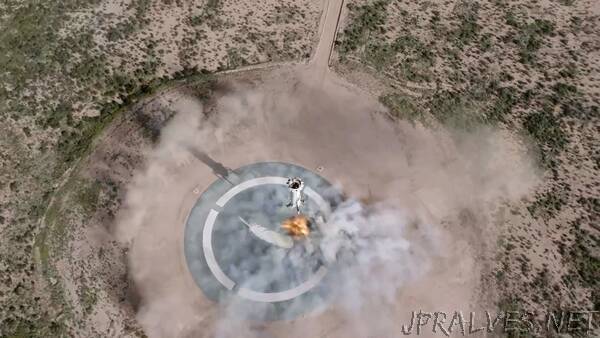
“Blue Origin successfully completed the 17th New Shepard mission to space and back for the program, and the 8th consecutive flight for this particular vehicle.
Today’s flight featured payloads on board supported by NASA’s Flight Opportunities program and included a second flight of the Deorbit, Descent, and Landing (DDL) Sensor Demonstration under a NASA Tipping Point partnership. The DDL demonstration, which flew for the second time mounted on the exterior of New Shepard’s booster, tested technology designed to achieve high-accuracy landing for future Moon missions. This aims to enable long-term lunar exploration.
“After flying more than 100 payloads to space on New Shepard, today’s 8th flight of this vehicle carried NASA-sponsored and commercial experiments, including the second flight of NASA’s lunar landing technology that will one day allow us to further explore the Moon’s surface,” said Bob Smith, CEO, Blue Origin. “We are grateful to NASA for partnering with us once again on this experiment, and we are proud of the Blue Origin team for executing a great flight in support of all our customers.”
Other payload highlights included a second flight of the OSCAR Trash-to-Gas payload, which evaluated a system that helps process trash samples into useful gases; the University of Florida’s third flight of the “Biological Imaging in Support of Suborbital Science” experiment, which further tested the calibration of data collection for biological experiments; and Suborbital Triptych, a work of art by Ghanaian artist Amoako Boafo painted on three exterior panels on the crew capsule.
Key Mission Stats
- 8th consecutive successful flight to space and back for this New Shepard vehicle.
- 18th consecutive successful crew capsule landing (every flight in program, including a pad escape test in 2012).
- The crew capsule reached an apogee of 343,787 ft above ground level (AGL) / 347,434ft mean sea level (MSL) (104.8 km AGL / 105.9 km MSL).
- The booster reached an apogee of 343,385 ft AGL / 347,032 ft MSL (104.7 km AGL / 105.8 km MSL).
- The mission elapsed time was 10 min 15 sec and the max ascent velocity was 2,232 mph / 3,592 km/h.
- The mission carried thousands of postcards from Club for the Future, Blue Origin’s foundation.
All mission crew and onsite personnel supporting this launch exercised safety measures to mitigate COVID-19 risks to themselves, customers, and surrounding communities.”
